Just before noon on Jan. 31, 1961, the Redstone rocket carrying the Mercury space capsule rose from Cape Canaveral, Fla. A few minutes later, the capsule broke free and climbed toward its apogee of 157 miles.
Inside, cool as a cucumber and performing his duties perfectly, was a 37-pound chimpanzee known previously as Chop Chop Chang or simply Number 65. On this mission, he would earn his new name, Ham, derived from an acronym of his home unit, the Holloman Aeromedical Laboratory in New Mexico.
Animals, notably monkeys and dogs, had been shot into space before, but always as inactive passengers. Ham’s flight was more than that. He had things to do and levers to push—more than 50 actions to perform during his suborbital trip. During his 16.5-minute flight, Ham experienced 6.6 minutes of weightlessness and pressures equal to 14.7 times the force of gravity, but his response times were as good as they were on Earth.
Through no fault of Ham’s, the capsule overshot its planned trajectory. It splashed down in the Atlantic Ocean 422 miles from Cape Canaveral. The capsule was damaged in the landing and began to sink, but a Navy helicopter arrived soon and rescued Ham. Aboard the recovery ship USS Donner, Ham shook hands with the captain and ate an apple and half an orange. Ham had demonstrated he could function in space. It was up to humans to prove they could do as well.
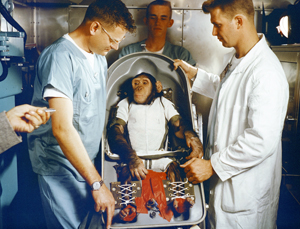 |
Chimpanzee No. 65, subsequently known as Ham, settles into his form-fitting “couch” before being launched on his suborbital flight. At left is his handler, MSgt. Edward Dittmer. |
On April 12 (71 days after Ham’s flight), Soviet cosmonaut Yuri Gagarin, the first man in space, made a full orbit of Earth in Vostok 1. On May 5 (94 days after Ham), Alan Shepard became the first American astronaut in space. His suborbital flight in Freedom 7 used the Redstone rocket and Mercury capsule validated by Ham. Fifty years later Ham is remembered—with the possible exception of Cheeta in the Tarzan movies—as the most famous chimpanzee of all time.
Animals in Space
In the postwar period, the United States and Soviet Union conducted numerous experiments with animals carried aboard rockets. Subjects included monkeys, mice, dogs, and in at least one instance, fruit flies. The first primate in space was Albert, a rhesus monkey who rode a US-launched V-2 rocket to an altitude of 39 miles in June 1948.
As the prospect of human spaceflight drew near, the need for testing increased. Little was known about the effects and stresses of weightlessness and high G forces, and whether astronauts could function—or even survive—in the environment of space.
“Before a man is lifted into space, we must learn whether an animal in space can perform tasks that it has learned on the ground,” an Air Force spokesman said. “If the animal’s sensory or motor abilities are impaired so it cannot perform these tasks, we must assume that a man suffering the same impairment will be ineffective as a monitor of dials or a reporter of information.”
Holloman Air Force Base, near Alamogordo, N.M., was one of the main sites for research about problems pilots could encounter in high-altitude aircraft and spacecraft. Animal rights activists today cite the risks and the high mortality rate for early test animals. However, the knowledge was so critical that humans took extraordinary risks, too. Col. John P. Stapp, head of the aeromedical laboratory at Holloman in the late 1950s, personally made 29 rocket sled runs, including one on Dec. 10, 1954, during which he accelerated to 632 mph and stopped in 1.4 seconds, subjecting himself to more than 42 times the force of gravity.
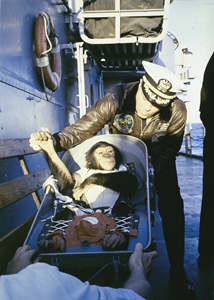 |
Ham “shakes hands” with the captain of the recovery ship USS Donner. (NASA photo) |
Project Mercury, the US human spaceflight program, conducted tests in two phases, beginning with small primates and progressing to experiments with chimpanzees, whose metabolic and physical similarities to humans were greater. Public interest was considerable, and some of the animals became celebrities.
In May 1959, a rhesus monkey named Able and a tiny squirrel monkey named Baker rode in the nose cone of a Jupiter missile to an altitude of 300 miles. Baker, aka Miss Baker, weighed only 11 ounces. Her space capsule was the size of a large thermos bottle.
The two monkeys appeared at a press conference, munching peanuts and crackers, and were featured on the cover of Life magazine. Able died a few days later during a medical procedure to remove an electrode, but Baker lived another 25 years, mostly at the US Space and Rocket Center in Huntsville, Ala. Baker received 100 to 150 letters a day from schoolchildren who read about her. More than 300 people attended her funeral in 1984. Her gravestone at the entrance to the Rocket Center reads: “Miss Baker, squirrel monkey, first US animal to fly in space and return alive. May 28, 1959.” Sometimes visitors leave bananas instead of flowers.
Another rhesus monkey, Sam (named for USAF’s School of Aerospace Medicine), made national headlines in December 1959 when he survived the deliberate abort and premature separation of a Mercury capsule from the rocket in a test of the launch escape system.
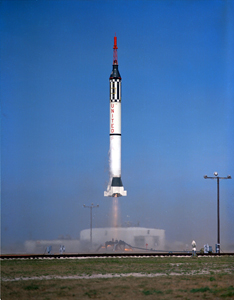 |
The capsule containing Ham on liftoff from Cape Canaveral, Fla. Monkeys had flown into space before, but never higher-order primates. |
Banana Pellets
The “Chimp in Space” project began at Holloman in 1958 to test the life support systems of Mercury spacecraft as well as the effects of spaceflight.
There were 65 chimpanzees at Holloman, and the 6571st Aeromedical Research Laboratory was assigned to train them, prepare them for flight, and handle them after recovery. MSgt. Edward C. Dittmer was the longtime noncommissioned officer in charge of training for the chimpanzees who were candidates for space travel. He was also the handler for the two chimps who eventually flew in space, Ham and Enos.
The space chimps began their training in the spring of 1959, at the same time as Mercury astronauts. “Eventually one of the beasts would be chosen for what amounted to a dress rehearsal of the first manned flight,” Tom Wolfe said in his chronicle of the early astronauts, The Right Stuff.
The chimps got plenty of cuddling and attention from human attendants. “They are taught to wear carefully fitted space suits and to tolerate being strapped for long periods on softly padded contour couches,” Time magazine reported. “They are taken up in stunting aircraft to get accustomed to sudden noise, vibration and G forces, and to learn what weightlessness feels like.”
They were trained by operant conditioning. The control panels of their trainers had two levers and two lights. The task was to pull the right-hand lever when the white light came on and the left lever in response to the blue light. When they did it right, a banana-flavored pellet was dispensed as a reward. When they did it wrong, they got a mild electric shock to the bottoms of their feet. During the actual spaceflight, how well they worked the levers would test the capability to perform and operate in space under conditions of weightlessness and high G forces.
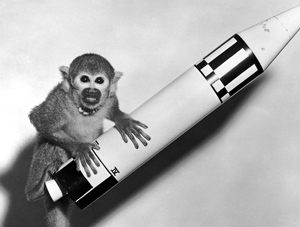 |
Miss Baker, a squirrel monkey, poses with a model of the Jupiter missile that carried her to an altitude of 300 miles. Some visitors leave bananas instead of flowers at her grave in Huntsville, Ala. |
The chimpanzees were more skillful than humans in working with the lights and levers in the capsule mockup. According to Life, “One female chimp learned to work the levers with her feet and kept her hands free to grab pellets.”
Ham, Minnie, and Enos
In January 1961, six chimps (four female, two male) and their handlers moved from Holloman to Cape Canaveral and into a compound behind “Hangar S.” They worked out on their Mercury capsule trainers and awaited the first mission, which was scheduled for Jan. 31.
It was not until the night before that Project Mercury officials chose Chop Chop Chang (Ham)—who was “exceptionally frisky and in good humor”—to fly the mission and picked a female chimpanzee named Minnie as his backup. Ham was born in Cameroon in West Africa in July 1957 and was brought to Holloman in 1959. He was affectionate and cuddly. “He’d put his arm around me and he’d play, you know,” Dittmer said. “He was a well-tempered chimp.”
Ham’s mission down the Atlantic Test Range was designated Mercury-Redstone 2. Ham returned to the Cape as a candidate for the second chimp mission into space, Mercury-Atlas 5, on Nov. 29, 1961, but his spacefaring days were over.
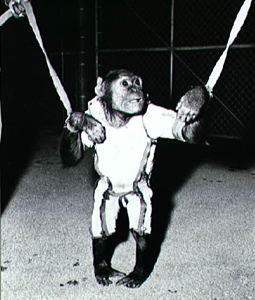 |
Enos, the second chimp in space, was less friendly than Ham (note wrist tethers). He was an exceptional spacefarer, though, and continued to pull levers correctly despite a malfunction in his capsule’s control system that delivered mild shocks to his feet. |
The chimp-onaut for the second mission was Enos, aka Number 85, who was regarded as the brightest and quickest member of the chimp colony. Like Ham, he was born in Cameroon and came to Holloman in April 1960.
But unlike Ham, he was not friendly or cuddly. He was quick to bite. “Enos was a good chimp,” said Dittmer. “He was smart but he didn’t take to people, very little. They said he was a mean chimp, but he wasn’t really mean. He just didn’t take to cuddling.”
Enos was a little older and a little larger than Ham was at the time of the first flight, and since his mission was more complex, his training was more intensive. He had undergone 1,263 hours of training, 343 of them in the Mercury capsule simulator. At 10:07 a.m. on Nov. 29, the Atlas missile booster lifted Enos and the Mercury capsule from the Cape for what was intended to be three orbits of the Earth.
Whatever Enos lacked in warmth, he more than made up for in operational ability. He was the epitome of the “Right Stuff.” Shortly into the flight, the lever for the motor skills testing malfunctioned. No matter how Enos performed his tasks, he got a shock to the bottoms of his feet. That did not hamper him. He continued to pull his levers correctly.
The mission was terminated after two orbits, not because of anything Enos did wrong but as the result of an attitude control system malfunction. The capsule splashed down off Puerto Rico following a flight of three hours and 21 minutes.
Enos blazed the way for John Glenn’s Friendship 7 orbital flight Feb. 20, 1962. When Glenn later met the President’s four-year-old daughter, Caroline Kennedy, in Washington, her first question was, “Where’s the monkey?”
Data recorded from the missions found that pulse and respiration rates and blood pressures for Ham and Enos were unexceptional during their flights and that performance of their tasks “was unaffected by the weightless state.”
Not that either Ham or Enos liked spaceflight. After Ham’s mission, the press wanted more photos of him in his contour couch, but he resisted being strapped back into it and no amount of urging could persuade him otherwise. When the capsule was opened on the second mission, Enos ran out and jumped into Dittmer’s arms, making an exception to his no-cuddling rule.
Ham returned to Holloman where he was kept under careful observation for any developing indications of ill effects from spaceflight. In 1963, he moved to the National Zoo for a long stay as the resident celebrity. Visitors usually found him genial and in good temper. When groups of schoolchildren came to see him, Ham would step to the front of his cage and listen with attention to what the teacher escorts had to say. He grew taller and gained weight, none of it fat, during his time in Washington.
In September 1980, he moved to the North Carolina Zoological Park in Asheboro, where he socialized with other chimps and found a girlfriend. Ham died Jan. 19, 1983, at age 26. His skeleton was preserved for ongoing examination by the Armed Forces Institute of Pathology, but his other remains were laid to rest in front of the flagpole at the International Space Hall of Fame and the New Mexico Museum of Space History in Alamogordo.
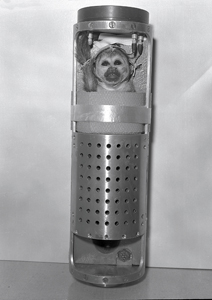 |
Miss Baker, all 11 ounces of her, in her bio-pack being readied for her Jupiter mission. The capsule was the size of a thermos. |
Minnie died in 1998 at age 41, having given birth to nine offspring. Enos died Nov. 4, 1962, of dysentery, not related to the space program. The disposition of Minnie’s and Enos’ remains is unknown.
Retirement was less auspicious for the rest of the Project Mercury chimpanzees. By the 1970s, they were no longer needed for the space program and many of them became subjects for medical research. In 1998, the Air Force divested itself of the chimpanzee colony. Of the 141 chimps then at Holloman, 30 went to the Primarily Primates sanctuary in San Antonio and the others were taken over by a private biomedical testing organization that assumed control of the facility at the base. In 1999, another 21 of the chimps moved from Holloman to the Save the Chimps sanctuary in Florida.
The National Institutes of Health took over ownership of the Holloman chimps in 2000 and established the Alamogordo Primate Facility, located on the base, in 2001. Currently, 186 chimps are there. They have not been research subjects since 1995. NIH planned to allow medical research to resume, but has backed down—at least for now—under pressure from animal rights activists, including the world’s leading authority on chimpanzees, Jane Goodall.
Space Pioneers Not Forgotten
In April 2009, Scott Carpenter, one of the original Mercury astronauts, and Robert Crippen, commander of the first space shuttle mission, toured the Save the Chimps sanctuary near Fort Pierce, Fla. The 286 chimpanzees residing there include some descendants of the Holloman chimp-onauts, among them Li’l Mini, youngest offspring of Minnie, who was Ham’s understudy for the first mission.
At the 150-acre park, the chimps cavorted on ropes and swings and lounged about eating popsicles. As Carpenter and Crippen drove through in golf carts, the chimps jumped and screamed and amused themselves by spitting water on anyone who got too close.
“There were a lot of unknowns back in the ’50s about how the human body would react to space and some real bad concerns that you might die,” Crippen said. “And these guys opened that up to at least give people confidence that it was OK to put Al Shepard and the guys up for the first time.”
“I have great respect for space travelers more senior than I, and I have great respect for the species that did it first,” Carpenter said.
